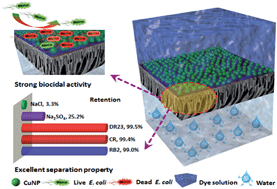Elevated salt transport of antimicrobial loose nanofiltration membranes enabled by copper nanoparticles via fast bioinspired deposition†
Abstract
Surface functionalization with advanced nanomaterials offers tailored control and targeted design of surface properties, endowing materials with enhanced or new qualities such as high hydrophilicity, excellent selectivity and permeability, and enhanced antimicrobial activity. In this study, we develop two strategies (two-step deposition/co-deposition) that use mussel-inspired polydopamine (PDA) to strongly immobilize copper nanoparticles (CuNPs) onto a porous polymeric membrane, bridging the surface cavities from ultrafiltration (UF) to loose nanofiltration (NF). To confirm the optimization of membrane properties, a series of characterizations were carried out: SEM, EDX analysis, AFM, water contact angle, and zeta potential measurements. The results indicate an overall high performance of surface properties with a homogeneous nanoparticle distribution, low roughness, favorable hydrophilicity, and relatively neutral charge. Co-deposition of PDA and CuNPs exhibits a facile and time-saving process that expedited a higher CuNP loading compared to the two-step strategy, as confirmed by SEM and AFM images. The integration of polyethylenimine (PEI)-modified CuNPs with high density of positive charges plays an important role in fine-tuning the hydrophilicity and compatibility with PDA and in largely neutralizing the negative charge of PDA, thus promoting an outstanding salt permeation (82% Na2SO4, 98% NaCl). In addition, CuNP/PDA-modified membranes show an ultra-high rejection of three types of textile dyes (600–800 Da, >99.0%), demonstrating superior NF performance. Furthermore, the functionalized membranes display distinct bactericidal activity with a great reduction of 93.7% in the number of live Escherichia coli (E. coli) bacteria. This study highlights a fast, facile co-deposition strategy to assemble multifunctional coating onto a UF support, which renders a vast potential for the fractionation of dye/salt mixtures.


 Please wait while we load your content...
Please wait while we load your content...